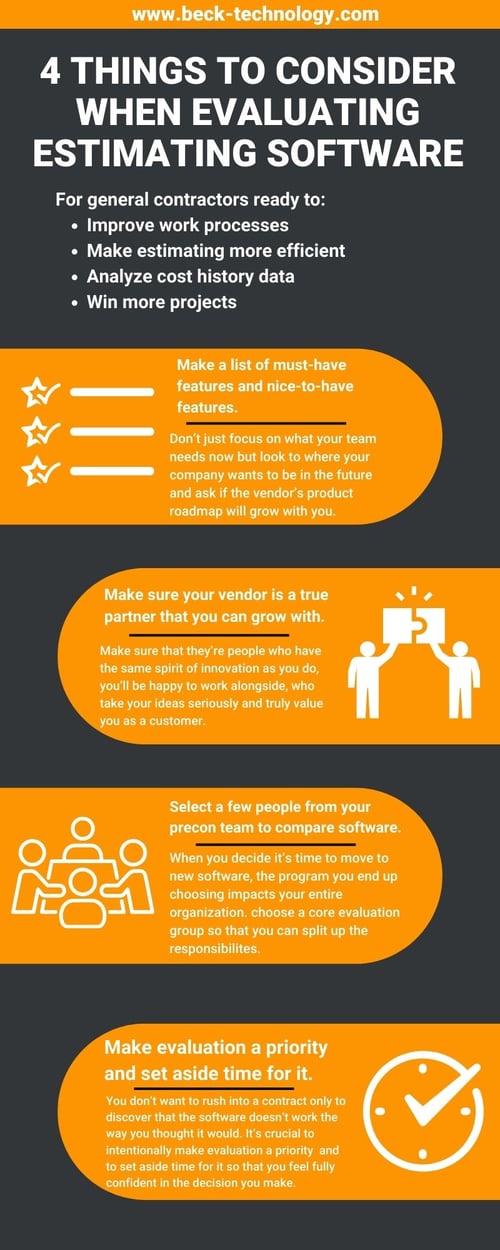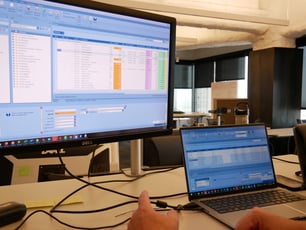4 Things to Remember When Evaluating Estimating Software
What do you use to create your estimates? Is it software made for construction estimating?
Maybe your preconstruction software isn’t really estimating software at all but just stacks and stacks of Excel spreadsheets. Or maybe your estimating software is so old, it’s completely outdated and unsupported. Maybe you’re just ready to move on to a product with more integration and one centralized database like Beck Technology’s revolutionary DESTINI Estimator.
If you’ve ever Googled “best estimating software,” the search return is seemingly endless. You’ll get everything from home renovation and car repair estimating tools to accounting software. A software that says it estimates construction projects might just end up being a beefed-up Excel emulator.
In construction, we know all about finding the right tool for the job and it’s no different when searching for new software.
For general contractors ready to:
- Improve work processes
- Make estimating more efficient
- Analyze cost history data
and most importantly…
- Win more projects
it’s time to start looking at software made specifically for preconstruction estimators.
Are you ready to begin your construction estimating software evaluation? If so, we have four important things to remember when evaluating software.

- Make a list of must-have features and nice-to-have features.
As the song goes, you might not always get what you want, but sometimes you get what you need. The same goes for evaluating preconstruction software. It’s important to get together with your team and decide on the features you absolutely need to have a successful estimating effort, and what features are the cherries on top.
As an example, DESTINI Estimator offers both 2D and 3D takeoff features. While many of our clients are drawn in by 2D takeoff, most of them are just beginning to experiment with 3D takeoff—only a few have 3D takeoff as a required feature for their precon teams. However, as preconstruction technology trends grow and catch on, features like 3D takeoff will be a necessary feature.
It is important to not just focus on your precon team’s needs now, but look into where your company is headed and anticipate features you’ll need in the future. It is way more cost-effective to pick a software that offers nice-to-have features now versus purchasing a software that only offers the bare minimum of necessary requirements, leaving no bells and whistles to explore later.
Like they say, “it is better to have it and not need it, then need it and not have it.”
- Make sure your vendor is a true partner that you can grow with.
It doesn’t matter if a software is the most cutting-edge right now if they can’t say that next year or the year after that. It also doesn’t matter how many fancy features they have if they never listen to your feedback or requests, and especially if they don’t have a support team to help you out if and when you run into a bug. So, as you’re comparing software, remember that you’ll also be choosing to work with the vendors behind them. Make sure that they’re people who have the same spirit of innovation as you do, people you’ll be happy to work alongside, people who take your ideas seriously and truly value you as a customer.
At Beck Technology, we’re very proud to say we wholeheartedly listen to our customers and do everything we can to make DESTINI Estimator work for your team. Our development team writes code every day based on customer feedback to give clients the individual features and functionality they need in our product.
- Select a few people from your preconstruction team to compare software.
When you decide it’s time to move to new software, the tool you end up choosing won’t just impact you—it impacts your entire organization. That’s why it’s key to choose a core evaluation group so that you can split up the responsibility of research and start comparing much more quickly.
When Haselden Construction began looking to switch from using MC2 to a new construction estimating system, they developed a matrix system called “Choosing By Advantages.”
Watch Haselden’s approach to evaluating and implementing new software in this webinar.
4. Make evaluation a priority and set aside time for it.
Let’s face it—as much as we would like software evaluation to just take a couple of days or so, it’s always going to be a bit of an investment when it comes to time, especially if you want it done well. You don’t want to rush into a contract only to discover that the software isn’t what you need or doesn’t work the way you thought it would. That’s why it’s crucial to intentionally make evaluation a priority for your team and to set aside specific slots of time for it so that you feel fully confident in the decision you make.
New software is an investment, yes, but ultimately, it's an investment in your company’s future. When you eliminate risk, stop wasting estimators’ time, and produce better, more accurate estimates, your return on investment will be clear.
For more answers to how to evaluate software, read the following software evaluation guides:
- Transforming Your Construction Estimating Software Evaluation
- Software Evaluation Made Easy
- How to Know When It’s Time to Invest in New Technology

-1.png?width=112&height=112&name=image%20(4)-1.png)















